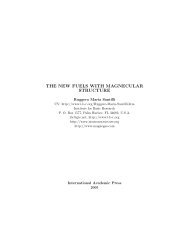hadronic mathematics, mechanics and chemistry - Institute for Basic ...
hadronic mathematics, mechanics and chemistry - Institute for Basic ...
hadronic mathematics, mechanics and chemistry - Institute for Basic ...
Create successful ePaper yourself
Turn your PDF publications into a flip-book with our unique Google optimized e-Paper software.
HADRONIC MATHEMATICS, MECHANICS AND CHEMISTRY 27<br />
Figure 1.8. A schematic illustration of the fact that the electron in beta decays can be emitted<br />
in different directions. When the energy in the beta decay is computed with the inclusion of<br />
the Coulomb interactions between the expelled (negatively charged) electron <strong>and</strong> the (positively<br />
charged) nucleus at different expulsion directions, the nucleus acquires the “missing energy,”<br />
without any energy left <strong>for</strong> the hypothetical neutrino. As we shall see in Chapter 6, rather than<br />
being a disaster, the occurrence is at the foundation of a possible basically new scientific horizon<br />
with implications sufficient to require studies over the entire third millennium.<br />
troversies have occurred in regard to experimental claims of neutrino detection<br />
voiced by large collaborations.<br />
To begin, both neutrinos <strong>and</strong> quarks cannot be directly detected as physical<br />
particles in our spacetime. Consequently, all claims on their existence are indirect,<br />
that is, based on the detection of actual physical particles predicted by the<br />
indicated theories. This occurrence is, per se, controversial. For instance, controversies<br />
are still raging following announcements by various laboratories to have<br />
“discovered” one or another quark, while in reality the laboratories discovered<br />
physical particles predicted by a Mendeleev-type classification of particles, the<br />
same classification being admitted by theories that require no quarks at all as<br />
physical particles, as we shall indicate in Chapter 6.<br />
In the 1980s, a large laboratory was built deep into the Gran Sasso mountain<br />
in Italy to detect neutrinos coming from the opposite side of Earth (since the<br />
mountain was used as a shield against cosmic rays). Following the investment of<br />
large public funds <strong>and</strong> five years of tests, the Gran Sasso Laboratory released no<br />
evidence of clear detection of neutrino originated events.<br />
Rather than passing to a scientific caution in the use of public funds, the failure<br />
of the Gran Sasso experiments to produce any neutrino evidence stimulated














